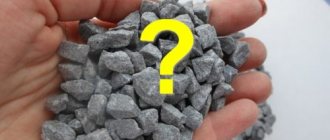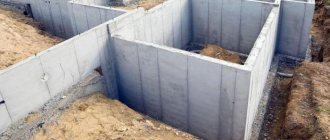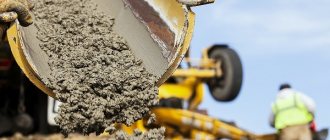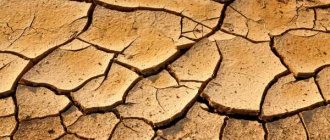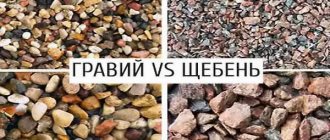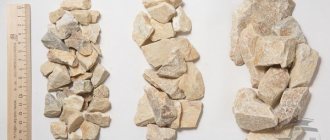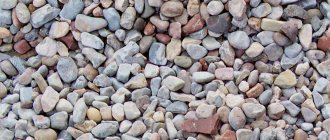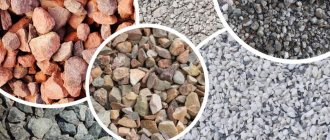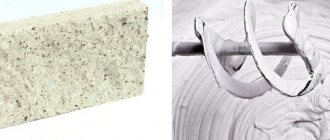Every private developer has a question regarding the quality of purchased building materials. That is, how sufficient it is to talk about the quality of the constructed building. In this article we will not talk about all building materials, because we will be interested in only one - crushed stone. Or rather, the question is what kind of crushed stone is needed for the foundation.
Crushed stone for the foundation of a private house Source stroybrend.ru
Characteristics of crushed stone
In fact, the question posed by this article is not trivial. Because the foundation is the basis of the structure, the quality of which determines how many years the entire structure will serve its owners without problems. And since crushed stone is an ingredient in the concrete mortar used in the construction of the foundation structure, it must be chosen correctly accordingly.
Moreover, several state standards have been prepared and approved regarding this building material. They define the characteristics of crushed stone, its purpose in various building structures, plus the requirements for the material itself in terms of fractionation.
Today, manufacturers offer a fairly wide range of crushed stone, which is divided into several types and types that differ from each other in characteristics. The latter include:
- what raw materials it is made from;
- material strength;
- factionalism;
- frost resistance;
- flakiness;
- degree of cleanliness, including environmental.
It is these characteristics that are taken as the basis for the choice. They are the ones who answer the question - what crushed stone is used for concrete. Let's look at this building material for each characteristic separately and identify the necessary option for the foundation concrete mortar.
Crushed stone is selected according to its characteristics Source nafundamente.ru
Crushed stone material
Let's start with the fact that crushed stone is a material belonging to the category of bulk inorganic. The technology of its production is the crushing of rocks or waste from certain industries, followed by separation into fractions by sifting.
So, the raw materials for the production of crushed stone are:
- stone rocks with high strength;
- waste from stone processing;
- slags, which are industrial waste from thermal power plants and metallurgical industries;
- building structures made of concrete, which are elements of dismantled buildings and structures, or which are defective reinforced concrete products.
Selection by raw material Source derevyannyydom.ru
There are several rocks that are used to make crushed stone.
- Granite is the hardest and most durable stone. His choice accurately and unambiguously answers the question - which crushed stone is better for concrete.
- Limestone, also known as dolomite. Crushed stone is also produced from it. But this rock is not strong enough to be incorporated into the foundation structure. It is not even recommended to use it to form a pillow under the foundation. In addition, limestone, when interacting with moisture, is subject to erosion and quickly disintegrates into smaller pieces. It can be recommended to use it in foundation solutions that are erected for small, lightweight buildings. The advantage of crushed limestone is its low price.
- Crushed gravel. It is produced using the same technology, only the raw materials here are large pebbles and boulders, formed like river and sea sediments. This variety differs from gravel itself in that it has sharp and chipped edges than pebbles. Therefore, in concrete solutions, crushed stone adheres well to cement and other fillers. In this regard, pebbles are inferior to it. If you answer the question of which crushed stone is best to use for the foundation, then this option is one of the optimal ones.
Crushed stone from limestone rocks Source slavbeton.ru
Now slag crushed stone. The thing is that slag is not the same type of material. That is, in different industries, as waste, they differ from each other in porosity, density, chemical composition and other technical characteristics. Therefore, when choosing crushed stone for the foundation, you need to take into account each position. For example, the lower the density, the lower the strength. The same can be said about porosity.
Some slags are quite aggressive materials. Therefore, when they come into contact with the steel reinforcement of the reinforcing frame, they gradually disable it. Let us add that some species have increased background radiation. Therefore, the advice is that it is better not to use the slag option in foundations.
And last on the list is crushed concrete. Let's start with the fact that it is two times cheaper than granite. And this is a nice bonus. It would seem that this is the most ideal option, which forms the complete compatibility of two materials: concrete and concrete. But not everything is so clear with this material.
Recycled crushed concrete Source i.simpalsmedia.com
Firstly, recycled concrete is inferior in strength to stone. Therefore, it is recommended to add it to the solution if the grade of the latter is not lower than M200.
Secondly, the origin of the dismantled concrete structures is very important. That is, they must be environmentally friendly, without background radiation. After all, it is not always known from which area the used concrete products were brought.
Thirdly, crushed concrete should not contain inclusions in the form of glass, ceramics, insulating and finishing materials, wood and plastic. They will simply dramatically reduce the quality of the concrete solution. It is precisely this clean crushed stone that belongs to the first grade. If the above materials are present in crushed stone in the amount of 1-7%, then this is the second grade.
Attention! If crushed concrete does not have any documents confirming its origin and quality, then it is better to refuse to purchase it.
And the last thing about crushed concrete. It can be used in foundation mortars that are poured under buildings if the latter belong to the “light or commercial” category.
Concrete crushed stone with various admixtures Source crushconqld.com.au
See also: Catalog of house projects made of reinforced concrete panels
Factionalism
In this section we will answer the question of what fraction of crushed stone is needed for the foundation. And let’s immediately make a reservation that, regardless of the type and type of this material, all crushed products are divided by size. The fractionation process is carried out on special equipment called a screen. Essentially, these are several sieves with cells of different sizes.
Today, the division of material is divided into two groups: standard and non-standard. The first includes dimensions:
- 5-10 mm;
- 10-15;
- 15-20;
- 20-40;
- 40-80.
There is a European standard for the minimum size - 3-8 mm.
As for the non-standard option, this is crushed stone, which is produced to order. Its dimensions can be quite impressive. For example, 80-120 or 120-150 mm.
Manufacturers offer so-called screening, the granule sizes of which are 0-5 mm. This is a kind of sand that is actively used in construction.
Crushed stone divided into fractions Source pouron.com.au
So, what fraction of crushed stone is used for concrete. It all depends on what kind of house the foundation is being laid under. More often this is the middle fraction with sizes from 20 to 40 mm. But there are no special restrictions on the use of crushed stone of other fractions. But here, as has already been said, it is necessary to resolve the issue of load on the foundation.
Blind area and monolithic foundation
And if you need to equip a blind area, then what kind of crushed stone should be poured under the foundation and under the blind area? It must be a building material of one fraction, and the remaining requirements for crushed stone of the blind area are minimal, since there is no soil pressure on its surface. Therefore, crushed limestone is the best cheap option, but if granite or gravel crushed stone has already been purchased, the quality of the blind area will only improve.
Granite cube-shaped crushed stone of grade M 900-M 1200, with a grain size of 20-40 mm and a flakiness of ≤ 10%, is used as a concrete aggregate for a monolithic base. Such crushed stone will make the structure as durable as possible. Crushed gravel has a smoother surface, so its adhesion to concrete mortar will be worse. Crushed stone grade M 900-M 1200 can also be used in the manufacture of FBS (wall foundation blocks). In addition to foundation blocks made from heavy concrete grades, for the construction of a prefabricated foundation based on blocks or slabs, it is allowed to use expanded clay concrete building blocks or cinder blocks with a filler made not of crushed stone, but of expanded clay or slag.
Permanent address of the article
| Options | Regulations according to GOST | Crushed granite | Quartzite sand crushed stone |
| Fraction content, ≤% | |||
| 5 mm | 19,6 | 17,8 | |
| 5-20 mm | 80,4 | 82,8 | |
| Emptiness, % | 51,2 | 53,3 | |
| Content of flake fractions, % | ≤ 25 | 19,1 | 22,3 |
| Density, kg/m3 | |||
| Regulatory | 2620 | 2661 | |
| Average | 2615 | 2656 | |
| Bulk | 1350 | 1312 | |
| Water absorption,% | 0,5 | 0,7 | |
| Fragility | ≤ 1000 | 1200 | 1000 |
| Frost resistance | ≤ 50 | 150 | 150 |
Video description
In the video, a specialist explains which fraction of crushed stone to choose for the foundation:
Strength
The manufacturer determines this characteristic in laboratories. To do this, crushed stone granules are subjected to pressure under pressure. As soon as the stone is destroyed, this will be its strength, which will be displayed on the dial of the press.
This parameter is considered regulated, so there are precise strength characteristics to which the material is adjusted. Here they are:
- M200 is the lowest strength of crushed stone;
- M300 and M600 are low performance markings;
- up to M800 – medium strength;
- from M800 to M1200 – good strength;
- M1200 and M1400 are high-strength materials.
What crushed stone to use for the foundation – not lower than M1200. M800 is suitable for a pillow. If the structure is light, then M800 can be used for both the backfill layer and the foundation structure.
Attention! There is so-called crushed stone from concrete structures. Essentially, this is used crushed stone, which is mined by crushing previously used concrete structures. The strength of such crushed stone, regardless of the quality of the original raw materials, cannot be higher than M600. That is, you must firmly remember that used crushed stone from concrete structures cannot be added to the foundation mortar.
The granite version has the maximum strength, the lime and slag version has the minimum.
Testing crushed stone for strength Source avtoregionstroy.ru
See also: Catalog of popular plots in the Moscow region for the construction of a country house
Frost resistance
This characteristic is measured in cycles from complete freezing to complete thawing. At the same time, the material should not lose its technical and operational characteristics. This parameter is designated by the letter of the English alphabet – “F”. And the digital designations show exactly the number of cycles. The higher the number, the longer the material will last. This characteristic is also determined in the laboratory.
So, the frost resistance of crushed stone from different raw materials:
- granite – F300-F400;
- gravel – F200-F300;
- lime – F25-F100;
- slag – F75-F200;
- concrete – F50-F75.
What kind of crushed stone is needed for concrete for pouring a loaded foundation - not lower than F300.
Brand of crushed stone for frost resistance Source proconstr.ru
Flakiness
This is one of the important indicators that will affect the quality of the foundation structure. The very name of the characteristic comes from the word “bream”. This is a flat fish.
It is necessary to understand that the quality of adhesion of crushed stone with other ingredients of the concrete solution depends on the quality of the plane of the material granules. If they are smooth and even, the grip will be low. This means that there is a high probability of destruction of the concrete structure under the influence of loads acting on it.
If there are a large number of flat stones in the total mass of crushed stone, then the likelihood of getting a low-quality foundation is also high.
Therefore, the flakiness of crushed stone is influenced by two types of stones: flat-shaped, or in other words plate-shaped, and needle-shaped. The first is when the thickness of the stone is three or more times less than its length. The second is when the width of the granule is three or more times less than the length.
That is, it turns out that the flakiness indicator itself is the number of the two types of stones described above found in the total mass of building materials. Therefore, the lower the flakiness, the better.
The flakiness of crushed stone is within 15-20% Source prodomostroy.ru
Criterias of choice
In order to purchase high-quality crushed stone for concrete, you need to familiarize yourself with the basic selection criteria. The quality of the resulting composition will depend on this.
Fraction
Crushed stone for concrete fraction 5-10 mm
The ratio of concrete grade and crushed stone grade
There is also the option to use an online calculation calculator and calculate all the proportions.
After studying this information, you can understand what crushed stone is needed for concrete.
Video description
The video clearly describes the flakiness of crushed stone:
Radioactivity
Few people pay attention to this indicator. It has nothing to do with the technical characteristics of the material. But in modern life, where everyone has become more attentive to their own health, the radioactivity of purchased crushed stone is a very important indicator.
Therefore, we will immediately make a reservation that for residential buildings the radioactivity of any building materials should not exceed 740 Bq/kg. This value can be found in the quality certificate. Therefore, be sure to ask the seller for this document. If it is not there, then think about whether it is worth buying building materials whose quality has not been confirmed by anything.
Checking the radioactivity of crushed stone Source derevyannyydom.ru
Acceptance
The quality of crushed stone is checked in batches for each fraction separately. This takes into account:
- the presence of dust, as well as clay particles and lumps;
- the presence of rocks that are less durable in relation to the bulk;
- content of flakier grains in the composition of bulk material.
Sample preparation is carried out in accordance with current regulations. Such characteristics as strength and frost resistance are determined by the manufacturer every time the place of receipt of raw materials changes and periodically during scheduled tests.
The volume and weight of shipped crushed stone is determined by weighing the empty and loaded vehicle. In this case, the humidity and compaction coefficients of the material are taken into account. Stones are transported in bulk and stored under conditions that prevent clogging, soaking and contamination.
Crushed stone is one of the most popular components in construction. So, for foundations it is necessary both when mixing the concrete mixture and for installing an underlying cushion on the soil base. It would seem that in both cases the same material is used, but this is misleading. It turns out that crushed stone for the foundation cushion and for preparing the concrete mixture is selected according to its properties.
Tips for using crushed stone in the construction of a foundation structure
Now you understand that choosing crushed stone for making concrete mortar for the foundation is not as trivial as it might seem at first glance. To choose it correctly, you need to take into account a serious list of characteristics. But that's not all.
In order for the house to stand for decades and not create problems, it is necessary to pour a good foundation for it. And for this you will have to take into account some points that are usually associated with the specifics of building a private house.
- If your plans are to build a stone house with thick walls and powerful ceilings, then to form the foundation you will need granite crushed stone of the highest quality.
- If it is decided to erect a lightweight structure on the site, then a concrete solution mixed with lime crushed stone is suitable for the foundation structure.
- If the concrete will be mixed by hand, then you should not add large material to it. The optimal granule size should be within 20 mm.
- If a mesh with small cells is used as a reinforced frame for the foundation, then the crushed stone fraction should be smaller than the size of these cells.
- For the foundation cushion, crushed stone of medium strength is suitable, which is filled with a thickness of at least 30 cm and must be compacted.
Harmful components
Crushed stone must have good resistance to chemical reactions in the alkaline environment of cement. In addition, the stone cannot contain components that provoke corrosion of reinforcing bars and embedded parts. When mixing concrete, no harmful clogging inclusions should get into the solution along with the filler.
Impurities in crushed stone that reduce the strength of concrete:
- clay minerals;
- organic substances, including coal, acids, oil shale;
- asbestos;
- minerals subject to weathering - chlorites, apatites, phosphorites, etc.
The quality of the concrete surface, as well as internal corrosion of the monolith, is caused by:
- sulfur-containing minerals;
- mica;
- layered silicates;
- gypsum;
- iron oxides.
Corrosion of reinforcement in the body of concrete can be promoted by crushed stone, including halogen-containing minerals.
All of the impurities described above may be present in the rock, but not more than the values defined by the standards. Depending on the harmfulness of the components, their permissible content varies from 0.1-15% by weight or volume.
Main types of crushed stone
Crushed stone is a by-product of hard rock mining. It is obtained by processing stone blocks or crushing them. Depending on these factors, all crushed stone is classified by origin:
- Granite is the most durable of its kind. It is used in the construction of massive foundations for heavy buildings and objects of increased responsibility. The high cost does not favor the widespread use of granite crushed stone. This material is obtained by grinding granite blocks with further sorting into fractions. You can recognize the material by its characteristic black and gray color with mineral inclusions and tints.
- Gravel is the most popular and versatile type of crushed stone. Stones are obtained by crushing and sifting large blocks of compacted sedimentary rocks. The material is suitable for mixing concrete solutions in industrial and civil construction. Crushed gravel is heterogeneous in color; a batch may contain stones of different shades.
- Crushed limestone is obtained through the process of mining, processing and grinding sedimentary rocks rich in calcium. The material is suitable for increasing the frost resistance and strength of concrete stone for foundations and walls; lime-based building materials are made from it.
Thus, all main types of crushed stone are suitable for the construction of foundations.
